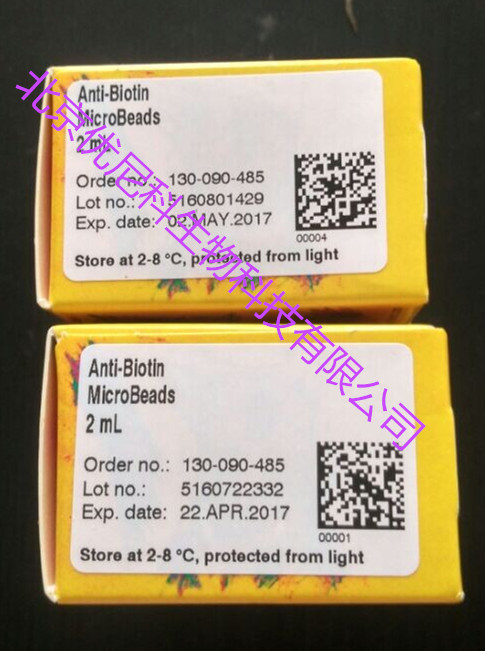- 欢迎来到北京优尼康生物科技有限公司
- |
-
商品分类

 010-64814275
010-64814275

 010-64814275
010-64814275

磁珠用于标记和分离细胞或其他生物质,如抗体或配合基.....。
描述:
Anti-Biotin MicroBeads have been developed for indirect magnetic labeling and separation of cells or other biological materials that are labeled with a biotinylated primary antibody or ligand, or with a cocktail of biotinylated antibodies. When working with debris-rich starting material and low frequency samples we recommend Anti-Biotin MicroBeads UltraPure to benefit from high specific enrichment with low background of debris and dead cells.
1. Description
Components 2 mL Anti-Biotin MicroBeads:
MicroBeads conjugated to monoclonal mouse
anti-biotin antibodies (isotype: mouse IgG1).
Capacity For 10⁹ total cells, up to 100 separations.
Product format Anti-Biotin MicroBeads are supplied in buffer
containing stabilizer and 0.05% sodium azide.
Storage Store protected from light at 2−8 °C. Do not freeze.
The expiration date is indicated on the vial label.
1.1 Principle of the MACS® Separation
First, the biological material of interest (e.g. cells, bacteria, or
subcellular material) is labeled with biotinylated antibodies or
ligands. Subsequently, the material is magnetically labeled with
Anti-Biotin MicroBeads. Then, the cell suspension is loaded onto a
MACS® Column, which is placed in the magnetic field of a MACS
Separator. The magnetically labeled material is retained within the
column. The unlabeled material runs through; this cell fraction is
thus depleted of magnetically labeled material. After removing the
column from the magnetic field, the magnetically retained material
can be eluted as the positively selected cell fraction.
To increase the purity, the positively selected cell fraction containing
the magnetically labeled cells can be separated over a second
column.
1.2 Background information
Anti-Biotin MicroBeads have been developed for indirect magnetic
labeling and separation of cells or other biological materials that
are labeled with a biotinylated primary antibody or ligand, or with
a cocktail of biotinylated antibodies. The biotinylated molecule
is recognized by a monoclonal anti-biotin antibody coupled to
MicroBeads. Anti-Biotin MicroBeads have the advantage of not
binding to free biotin, which is often present in culture media. This
feature provides the most sensitive labeling and separation of cells
注意事项:
Reagents contain sodium azide. Under acidic conditions sodium azide yields hydrazoic acid, which is extremely toxic. Azide compounds should be diluted with running water before discarding. These precautions are recommended to avoid deposits in plumbing where explosive conditions may develop.